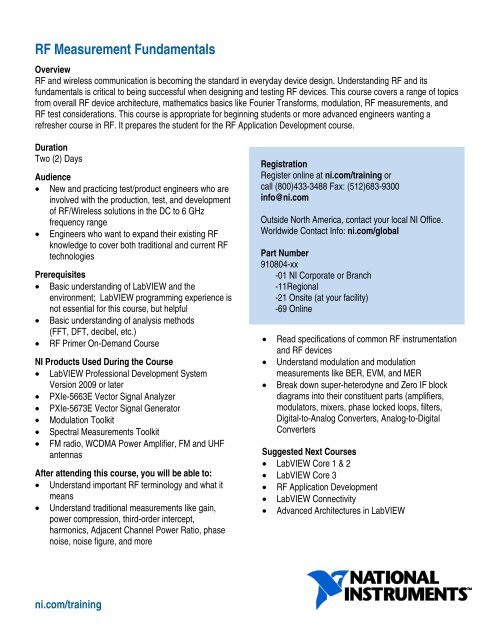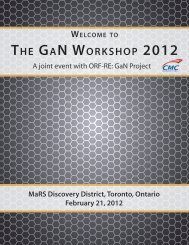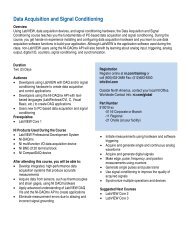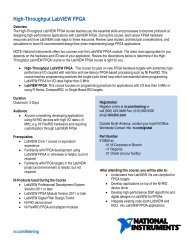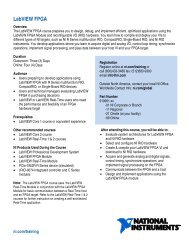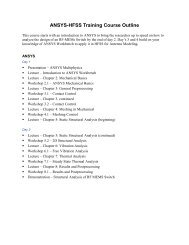RF Measurement Fundamentals
RF Measurement Fundamentals
RF Measurement Fundamentals
You also want an ePaper? Increase the reach of your titles
YUMPU automatically turns print PDFs into web optimized ePapers that Google loves.
<strong>RF</strong> <strong>Measurement</strong> <strong>Fundamentals</strong><br />
Overview<br />
<strong>RF</strong> and wireless communication is becoming the standard in everyday device design. Understanding <strong>RF</strong> and its<br />
fundamentals is critical to being successful when designing and testing <strong>RF</strong> devices. This course covers a range of topics<br />
from overall <strong>RF</strong> device architecture, mathematics basics like Fourier Transforms, modulation, <strong>RF</strong> measurements, and<br />
<strong>RF</strong> test considerations. This course is appropriate for beginning students or more advanced engineers wanting a<br />
refresher course in <strong>RF</strong>. It prepares the student for the <strong>RF</strong> Application Development course.<br />
Duration<br />
Two (2) Days<br />
Audience<br />
• New and practicing test/product engineers who are<br />
involved with the production, test, and development<br />
of <strong>RF</strong>/Wireless solutions in the DC to 6 GHz<br />
frequency range<br />
• Engineers who want to expand their existing <strong>RF</strong><br />
knowledge to cover both traditional and current <strong>RF</strong><br />
technologies<br />
Prerequisites<br />
• Basic understanding of LabVIEW and the<br />
environment; LabVIEW programming experience is<br />
not essential for this course, but helpful<br />
• Basic understanding of analysis methods<br />
(FFT, DFT, decibel, etc.)<br />
• <strong>RF</strong> Primer On-Demand Course<br />
NI Products Used During the Course<br />
• LabVIEW Professional Development System<br />
Version 2009 or later<br />
• PXIe-5663E Vector Signal Analyzer<br />
• PXIe-5673E Vector Signal Generator<br />
• Modulation Toolkit<br />
• Spectral <strong>Measurement</strong>s Toolkit<br />
• FM radio, WCDMA Power Amplifier, FM and UHF<br />
antennas<br />
After attending this course, you will be able to:<br />
• Understand important <strong>RF</strong> terminology and what it<br />
means<br />
• Understand traditional measurements like gain,<br />
power compression, third-order intercept,<br />
harmonics, Adjacent Channel Power Ratio, phase<br />
noise, noise figure, and more<br />
Registration<br />
Register online at ni.com/training or<br />
call (800)433-3488 Fax: (512)683-9300<br />
info@ni.com<br />
Outside North America, contact your local NI Office.<br />
Worldwide Contact Info: ni.com/global<br />
Part Number<br />
910804-xx<br />
-01 NI Corporate or Branch<br />
-11Regional<br />
-21 Onsite (at your facility)<br />
-69 Online<br />
• Read specifications of common <strong>RF</strong> instrumentation<br />
and <strong>RF</strong> devices<br />
• Understand modulation and modulation<br />
measurements like BER, EVM, and MER<br />
• Break down super-heterodyne and Zero IF block<br />
diagrams into their constituent parts (amplifiers,<br />
modulators, mixers, phase locked loops, filters,<br />
Digital-to-Analog Converters, Analog-to-Digital<br />
Converters<br />
Suggested Next Courses<br />
• LabVIEW Core 1 & 2<br />
• LabVIEW Core 3<br />
• <strong>RF</strong> Application Development<br />
• LabVIEW Connectivity<br />
• Advanced Architectures in LabVIEW<br />
ni.com/training
<strong>RF</strong> <strong>Measurement</strong> <strong>Fundamentals</strong> Outline<br />
Day 1<br />
<strong>RF</strong> SOC Device Architectures<br />
This lesson introduces you to common <strong>RF</strong> devices and<br />
their architectures. It also reviews orders of magnitude<br />
common to <strong>RF</strong>. Topics include:<br />
• Basic Radio Components<br />
• <strong>RF</strong> SOC Device Architectures<br />
• Superheterodyne Transceivers<br />
• Homodyne Zero IF (ZIF) Transceivers<br />
• Device Integration Paths<br />
Fourier Transforms and FFTs<br />
This lesson reviews frequency and time domain signals.<br />
It describes how the Fourier transform works and<br />
covers areas like Nyquist Sampling Theory, Signal to<br />
Noise Ratio and Complex FFT. Topics include:<br />
• Frequency versus Time Domain<br />
• Fourier Transform<br />
• Relationship of Time and Frequency<br />
• Nyquist Sampling<br />
• Coherent Sampling and Windowing<br />
• Signal to Noise Ratio (SNR)<br />
• IQ Modulation/Complex FFT<br />
Day 2<br />
<strong>RF</strong> Parametric <strong>Measurement</strong> Overview for Discrete<br />
Devices<br />
This lesson introduces you to important concepts in <strong>RF</strong>.<br />
It describes <strong>RF</strong> power and methods for measuring<br />
power. It covers noise in <strong>RF</strong> signals and measurement<br />
systems. The lesson also goes into details of important<br />
<strong>RF</strong> specifications for devices and instrumentation.<br />
Topics include:<br />
• <strong>RF</strong> Power<br />
• What is a spectrum analyzer?<br />
• Noise<br />
• Transmission Line Theory<br />
• Scattering Matrix (S-parameters)<br />
• Gain<br />
• Major <strong>RF</strong> <strong>Measurement</strong>s<br />
• Mixers<br />
• Intermodulation Distortion<br />
• Adjacent Channel Power Ratio (ACPR)<br />
• Phase Noise<br />
• M. Dynamic Range (DR) vs. Spurious Free<br />
Dynamic Range<br />
Complex and Digital Modulation<br />
This lesson introduces you to modulation and IQ data<br />
(complex data). It describes the different methods of<br />
digital modulation using phase and magnitude<br />
variations. It also introduces you to modulation<br />
measurements like Error Vector Magnitude (EVM) and<br />
Modulation Error Ratio (MER). Finally it describes IQ<br />
imbalances (impairments). Topics include:<br />
• Modern Digital Communication System<br />
• Modulation Basics<br />
• Modulation Techniques<br />
• EVM and MER<br />
• Imbalance Effects<br />
Bit Error Rate (BER)<br />
This lesson explains Bit Error Rate and why it is<br />
important for device testing. Topics include:<br />
• Receiver Tests Overview<br />
• Bit Error Rate (BER) Testing<br />
• BER Receiver <strong>Measurement</strong>s<br />
• Packet Error Rate (PER)<br />
ni.com/training


